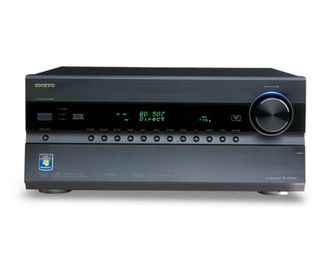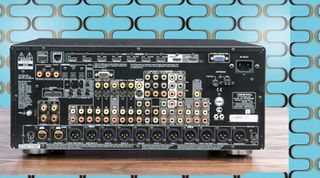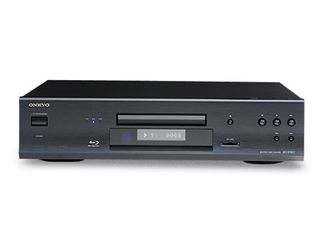TechRadar Verdict
This system offers almost everything a home cinema enthusiast wants. THX certification, great sound and picture quality and oodles of power on tap
Pros
- +
Excellent audio codec support
- +
Extensive connectivity
- +
Massive power reserves
- +
Smooth AV performance
Cons
- -
BD player lacks network streaming and content portal
- -
Sheer size and weight of the power amp may be a challenge for some
Why you can trust TechRadar
Of all the badges, on all the fascias, in all the world, THX remains a branding guaranteed to bring on anticipatory goosebumps. For me, the acronym is synonymous with home cinema excitement, and I still get chills when I hear the classic THX theme (played at the right reference level, of course).
In the spirit of full disclosure, I should reveal that this is probably because I was indoctrinated into the cult of THX early on, having been trained at Skywalker Ranch, earning my official THX installer certificate and getting a copy of the legendary THX WOW! Laserdisc in the process.
Obviously THX has changed much since then (not least in departing the aegis of Camp Skywalker), evolving dramatically with the arrival of Chief Scientist Laurie Hall in 1999, but I still largely subscribe to its tenets and appreciate using THX modes, even though I haven't owned a pair of THX-certified speakers in years.
While THX continues as a badge of honour on components at the higher end of the AVR market, it remains relatively unusual to see a full-on pre-power-component system built around the stamp. But that is exactly what we have here with the Onkyo THX Ultra2 system.
The beating heart of this system is the £1,800 PA-MC5500 power amp. Onkyo has offered AV processors for a couple of years, but been strangely slow to release a matching power amp. This is the reason.

First seen snarling in a cage at the 2009 IFA tech fest, the MC5500 is 26kg of godlike fury. With nine channels of amplification and THX Ultra2 certification, you know without even powering it up, it will smite like the hammer of Thor.
The arguments for and against using separate pre/pro components are as old as Norse legends, and the debate hasn't changed much of late. The logic of the 'for' camp is undeniable.
By separating transformer and amplification from digital electronics you're removing any possible contamination or influence upon audio and video signals. Taking such a pure approach also has an engaging simplicity that many find appealing, and usually comes with a promise of superior brawn – always convincing in a hardcore AV environment.
Against pre/power combos, of course, are issues of space and convenience. A fully integrated AVR solution is just more manageable – and few would argue that compromise arguments are significant at the well-resourced end of the AVR market.
While some of Onkyo's competitors have pursued digital amp solutions, the PA-MC5500 is entirely, classically analogue. Hooking it up to its matching SC5507 processor is straightforward. The back panel offers balanced gold-plated XLRs (the interconnect of choice for audiophiles), brass phonos by way of alternative (this was how I auditioned the system), and requisite banana plugs.

The power output of each identical amp module is rated at a not inconsiderable 220W (into 6Ωs) by the manufacturer. In our Tech Labs, we measured 160W into 8Ωs with two channels driven, but this drops to 120W with five channels driven and 110W with seven. It's worth noting that it's not particularly green, sucking 2,000W with seven channels on the go, dropping to 145W when idling.
As the THX certification will attest, this means there's enough power on tap to deliver reference level audio to a screening-room sized cinema. That translates in my listening room to enough energy to imperil the fixings of the drop-down screen, and rattle the air-con. I really don't recommend unleashing upwards of a kilowatt of power in a confined space – unless you're seriously deranged and/or watching 300 for the umpteenth time (one movie where you just have to play it louder with each spin. It's the rules).
The hi-fi avenger
Traditionally, I've found cheaper Onkyo AVRs to occasionally skimp on build quality (maybe one reason why they're often so darn affordable). But that's not the case with the MC5500. A steel chassis encases the unit-wide heatsink and ominous toroidal power transformer, resulting in a significantly hefty and well-built unit.
The MC5500 has been designed from the ground up to work with the £1,800 PR-SC5507 processor. Built into an AVR chassis, it ticks most of the boxes a demanding AVphile requires. It would be churlish to criticise a feature slate that leaves little to the imagination (so I won't), but it could be argued that at times it just doesn't go far enough.
For example, the SC5507 is only a partially-enabled DLNA network entertainment hub. Pedantically, this DLNA DMR (Digital Media Renderer) doesn't allow you to stream any form of video across your network, although it will access Music Shares on compliant servers. I hooked it up to my network and it immediately found my shambolic collection of NAS boxes and PCs.
The presentation of this network content is basic; you can browse music via standard artist/album/genre/etc tabs in a list format, but there is no support for cover art. This is one area I hope Onkyo develops in future.
File support is good, covering MP3, WMA, WAV, FLAC, Ogg Vorbis, AACS and LPCM. You can also access 'net radio stations via vTuner, or, if you're a subscriber, LastFM. There's a Music Optimizer mode (as well as some 'Neural' post processing) for compressed music, to eke the greatest clarity from files or streams. However, control over this portion of the system is clunky. The remote's logic is such that you need to engage the Net/USB button to browse and play connected sources.
However, if you toggle back to Receiver control on the remote, because, say, you want to engage a particular type of DSP processing, you lose Play/Stop transport control of the file. To regain this you need to hit Net/USB, which in turn stops any streaming music you may be listening to. There is a workaround, but it's too convoluted to bother with. Not particularly user friendly.
All bases covered
Connectivity is luxurious. There are seven HDMI v1.3 inputs, plus three component video inputs (which will steal from your HDMI selection options) and six legacy composite/S-video inputs. Digital audio inputs consist of three optical and three coaxial. Conveniently, there are two HDMI outputs, allowing you to feed both a monitor and projector.

Video processing is par for the up-market course. The processor will upscale all sources to 1080p over HDMI, courtesy of an HQV Reon-VX chip, and take analogue to 1080i where possible. Plus there's ISF video calibration, to optimise each video source on a per input basis, before sending the video signal to a display.
Root around under the front fascia flap and you'll find a USB port for portable media players and flash drives, another HDMI and AV grouped input, and an unusual addition to the back of this box is Onkyo's new Universal Port. This is a daisy-chain interface that allows various modules to be cabled into the system with a single interconnect (no additional power supply required).
Onkyo offers a DAB+ tuner (£130) and iPod dock (£150) although I didn't have these for testing. The unit also has an onboard FM tuner. Frankly, the latter is of zero interest to me, I never use them in AVRs (and I suspect I'm not alone).
A 12V trigger is used to tether the power amp to the processor. For further component control, two additional triggers are available if you need them. Beneath the hood are Burr-Brown 192kHz/32bit DACs on all channels and audio decoding is predictably comprehensive, with all flavours of DTS and Dolby supported.
There's also the Audyssey DSX processing suite onboard, for a front wide/front high speaker configuration, along with Dolby Pro-Logic IIz height processing. HCC's Richard Stevenson is a convert to front wide (which gives a forward-facing spread of five channels), but I'm more of a traditionalist. My preferred setup is classic 7.1. This system lets you adopt/experiment with both.
In keeping with the PR-SC5507's pure design ethic, there are separate power supplies for audio and video processing. While the processor lacks any implementation of the kind of next-gen HDMI reclocking we've seen from rival brands, it does sport low-jitter PLL (Phase Locked Loop) circuitry and high-quality silicon in the form of a trio of Texas Instruments Aureus 32bit chips assigned to handle DSP processing.
I would imagine that custom installers will appreciate the PR-SC5507's multizone capabilities, although they're largely lost on your humble reviewer (my idea of multiroom audio is to turn up the volume). Zone Two can have stereo audio, with video and subwoofer feeds. Zone Three can run stereo audio with a sub. RoomEQ Once installed, I immediately ran the Audyssey MultEQ room balancer. This is one of the better auto room balancing systems available, and it did a reasonably good job in my listening room.
However, there are times when you might want to listen to particular sources without Audyssey balance, but with your own preferred setup. In this case, one might expect to be able to save your settings to a bank of memories, which isn't the case here. If you toggle Audyssey off, you then have to manually reset all of the speaker balances.
The final component in this system is the £600 BD-SP807 Blu-ray deck. As with the processor and power amp, it comes THX-certified, making it the first such Blu-ray player in the UK. My initial impressions of this deck are positive.

It's a battleship grade BD-spinner that doesn't undersell itself when it comes to high-quality components. Beneath the lid is an Analog Devices 297MHz/12bit video DAC of some quality, while a 10bit Anchor Bay ABT1030 Video Reference Series chip upscales standard-def DVDs.
For superior audio performance there are 192kHz/24bit DACs. Unused in this configuration are seven analogue audio outputs. However, despite the creds, it's ultimately the least convincing component in the system. While I know and appreciate the various THX post-processing modes employed by the processor, I struggle to identify what the certification brings to this deck.
It looks lovely, and the fascia and chassis is admirable. However, the wobbly tray ejects with a curious rasp, and doesn't convince me this is premium kit. Disc-loading is hardly snappy, at 83 seconds for our standard BD test disc; audio jitter measurements are good but not outstanding at 451ps.
All video measurements can be considered excellent, however, and indicate superior circuitry and processing. The harsh fact is that Blu-ray players are being evolved at such a rate by the mainstream brands that hi-fi specialists like Onkyo have little hope of keeping up.
This may be a Profile 2.0 player, but the ethernet connectivity is reserved purely for BD-Live. There's no network functionality available, and certainly no access to online content portals. The best you get is an SD card slot for easy playback of music, movies and JPEGs. Video file support includes DiVX HD, AVI, regular DiVX and AVCHD.
Of course, if you want a full-blown THX system this fits the bill. I have no quibbles with its performance, video and audio quality are undeniably good. It's just the feature set which underwhelms.
As the BD player is not compatible with Super Audio CD or DVD-Audio, I reverted to an Oppo universal deck for some of my auditioning. This allowed me to listen to the SACD release of Pink Floyd's Dark Side of the Moon (30th Anniversary Edition), which has a memorable 5.1 mix from Alan Parsons.
As On the Run segues into Time, the Onkyo pre/power combo effortlessly engulfed me with deranged laughter and projected footsteps, before wrapping a 360° drape of ticking, chiming timepieces around my head. I had to take some central bass bloom from the Audyssey EQ'd balance (after all, this disc has a very bassy mix), but the resulting wall of sound was considerable.
Bowie's Heathen (another must-have 5.1 Super Audio CD), was delivered with astonishing clarity. Shut your eyes, and the imaging is razor-sharp. I must confess to really liking a fair few of the DSP modes offered by the processor. The Onkyo-specific treatments are fine (Orchestra, Unplugged, Studio-Mix, All-Channel Stereo) and the THX/Dolby/DTS options comprehensive. THX Surround EX (with Re-EQ Off) is superb with the Dolby Digital 5.1 from Sky.
The science-fiction drama Caprica uses a lot of surround steerage, particularly for sequences set in its virtual V-World, and these were sublimely placed by the Onkyo. While some receivers might simply pop FX into the back channel with all the subtlety of a rampaging elephant, the Onkyo smoothed them to create a convincing halo of surround audio.
With lossless formats from Blu-ray, the combination of monstrous power reserves and definition is beguiling. Of course, you might expect a system like this to be lauded for its home cinema prowess but rounded on for its musicality. I'd refute this.
The Onkyo system seems to be equally at home with any hi-res audio – be it music or movies. Ole Bull – Violin Concertos is the latest Blu-ray audio release from 2L, the Norwegian hi-res audio label. This platter contains a selection of gorgeous recordings of the working of the violinist known as the 'Scandinavian Paganini' in breathtaking detail, and you can choose to listen in 5.1 DTS-HD MA 24bit/192kHz, 7.1 DTS-HD MA 24/96kHz and stereo LPCM 24/192kHz.
The imaging and delicacy delivered by the Onkyo pre/pro is peerless. In a different vein, but equally enjoyable, is a FLAC recording of Hells Bells by AC/DC at 926kbps 16bit/44.1kHz. The stomping rock riffs ripple air.
High value, high-end
For a high-end audio proposition, the PR-SC5500/PA-MC5500 is surprisingly affordable. This pre/power combo typically sells for less than £4,000, and that strikes me as a bit of a bargain. Price-wise, it's comparable with the upper end of the integrated market, but in terms of performance, this THX Ultra2 duo will give most one-box solutions a spanking.
The tonality of the power amp in particular is wonderful; It's like being hit with a velvet hammer. The BD-SP807 Blu-ray player is understandably less compelling. It does what it needs to do rather well, and naturally, it's a great system match for the pre/power, but with rivals offering heaps of extras, from 3D Blu-ray compatibility to online connected content, it has its work cut out. Still, this shouldn't diminish what is a terrifically entertaining package.
Follow TechRadar Reviews on Twitter: http://twitter.com/techradarreview
Steve has been writing about AV and home cinema since the dawn of time, or more accurately, since the glory days of VHS and Betamax. He has strong opinions on the latest TV technology, Hi-Fi and Blu-ray/media players, and likes nothing better than to crank up his ludicrously powerful home theatre system to binge-watch TV shows.


